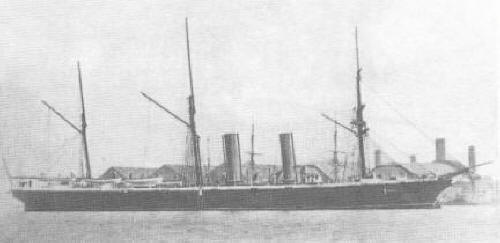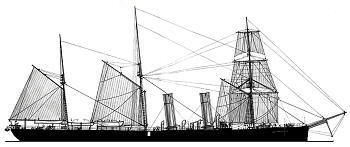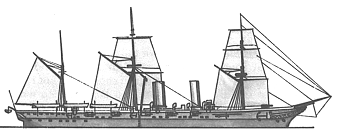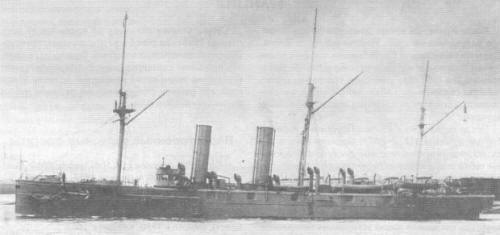
NAVYPEDIA
 Support the project with paypal
Support the project with paypal
Photo

Iris as completed
Ships
| Name | No | Yard No | Builder | Laid down | Launched | Comp | Fate |
|---|---|---|---|---|---|---|---|
| Iris | 191 | Pembroke DYd | 11.10.1875 | 12.4.1877 | 4.1879 | sold 7.1905 | |
| Mercury | 192 | Pembroke DYd | 16.3.1876 | 17.4.1878 | 9.1879 | submarine depot ship 1905 |
Technical data
| Displacement normal, t | 3730 |
|---|---|
| Displacement full, t |
|
| Length, m | Iris: 91.4 pp 101.5 oa Mercury: 91.4 pp 96.0 oa |
| Breadth, m | 14.0 |
| Draught, m | 6.71 |
| No of shafts | 2 |
| Machinery | sails + 2 4-cyl HC, direct action, 8 oval boilers, 4 cylindrical boilers |
| Power, h. p. | 6000 |
| Max speed, kts | 17.5 |
| Fuel, t | coal 780 |
| Endurance, nm(kts) | Iris: 4400(10) Mercury: 4950(10) |
| Armament | 10 x 1 - 160/16 64pdr 71cwt MLR |
| Complement | 275 |
Standard scale images

Mercury 1879

Iris 1879
Graphics
Project history
Britain's first warships to be constructed of steel, these two vessels were designed for high speed at the expense of protection and armament. Although classified as despatch vessels they originated the development of later cruiser designs and in the late 1880s they were reclassified as 2nd class cruisers. Iris was the first to run trials and considerably exceeded the designed power at 7086ihp although speed was only 16.6kts. However, after fitting new propellers, she achieved a remarkable 17.89kts with 7330ihp while Mercury, benefiting from the experience gained with her sister, made 18.57kts with 7735ihp, making her the fastest warship in existence at the time of her completion. Each ship had two engine rooms with the after engine driving the port shaft and the forward engine the starboard shaft. The boilers were equally disposed in two boiler rooms and each could be operated independently in the event of damage to the other. As no armour was fitted the ships were extensively subdivided with a double bottom over the full length of the machinery compartments (45.8m), while some protection was afforded by the coal bunkers which were arranged in wing compartments abreast the machinery extending from the main deck to the hold. The ships were completed with a light barque rig but after a few years in commission the yards were removed. The full coal stowage of 780t provided an endurance of 6000nm at 10kts or about 2000nm at full speed; nominal coal stowage was 500t. The original armament consisted of 10 64pdr MLR guns of which 4 were mounted on each side of the main deck and one each on the forecastle and poop. The two were very similar in appearance except that Iris had a clipper bow while Mercury had a straight stem.
Modernizations
1880, Iris: - 8 x 1 - 160/16; + 4 x 1 - 152/26 BL Mk II, 4 x 1 - 127/25 BL Mk I/II/III/IV/V
1886-1887, both: were completely rearmed with 13 x 1 - 127/25 BL Mk I/II/III/IV/V, 4 x 1 - 47/40 3pdr Hotchkiss Mk I, 4 - 356 TC
Naval service
Mercury became a submarine depot ship in 1905 and served as a hulk at Chatham in 1914-1918.
Many thanks to Wolfgang Stöhr for additional information on this page.
as completed
 HOME
HOME FIGHTING SHIPS OF THE WORLD
FIGHTING SHIPS OF THE WORLD UNITED KINGDOM
UNITED KINGDOM CRUISERS
CRUISERS IRIS dispatch vessels (2, 1879)
IRIS dispatch vessels (2, 1879)

